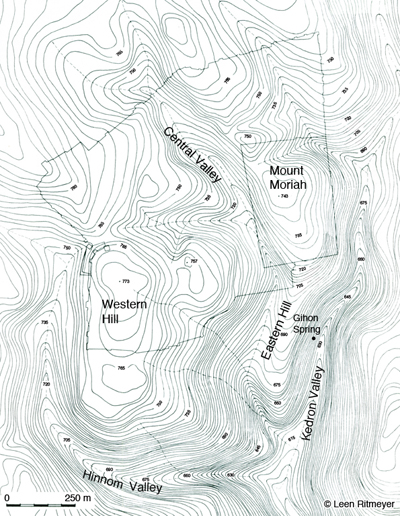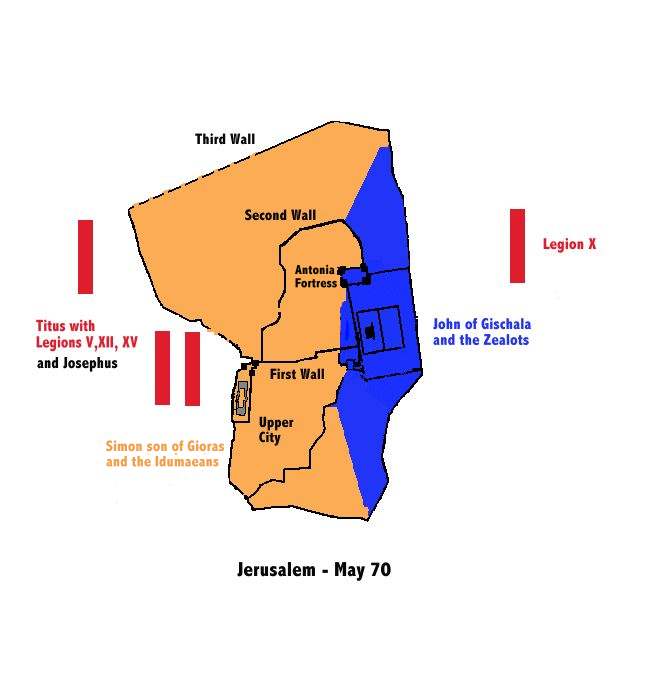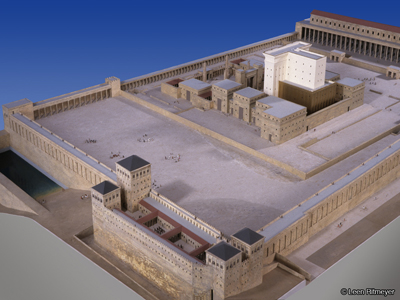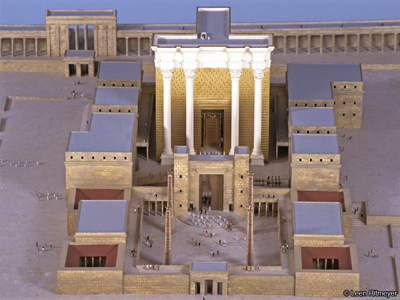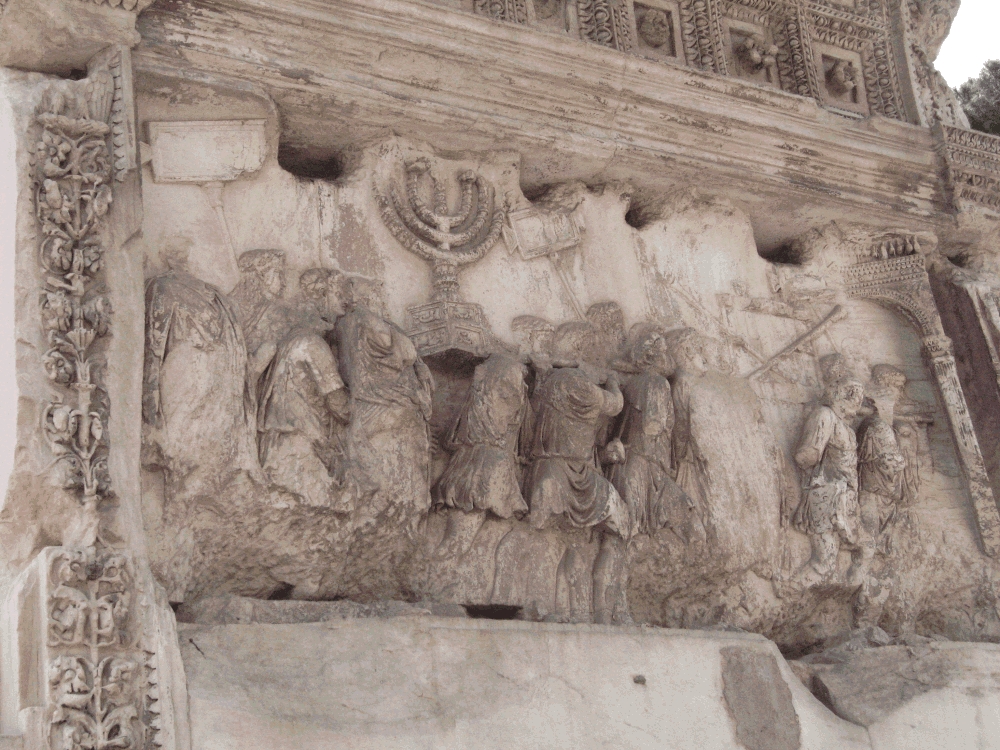Introduction
Now the threads come together: the warring factions, the anxious populace of Jerusalem, the Roman army, and Josephus. The distant civil war in Rome, which had provided the best hope for the Judean rebellion, had passed. Ironically -- or, as Josephus would have it, through the working of Divine Providence -- that opportunity was ended by the Judean war itself, as Vespasian's previous successes in Judea and Galilee propelled him to the imperial throne and brought peace to the city of Rome. Vespasian has now departed for Rome and has appointed his son Titus as commander to finish the war by taking Jerusalem.
Josephus' Praise of Titus
Critics of Josephus regard him as an untrustworthy propagandist for the Flavian dynasty, as evidenced by his treatment of Titus' actions at the siege of Jerusalem. His descriptions of Titus saving an entire legion by single-handedly fighting back crowds of armed Judeans are laughable. But modern readings of Josephus treat these embarrassing passages with more sympathy. Josephus did not have freedom of speech: he was living under a dictatorship, and over the past century we have had ample understanding of what that does to a writer.
Steve Mason summarized the rules of first-century literary Rome thus: "Flattery of the princeps is non-negotiable, and it is something of a game to see who can configure an argument most favourable to Caesar." ("Figured Speech and Irony in Josephus," in Flavius Josephus and Flavian Rome (Oxford, 2005), p. 259)
As an example, Josephus made use of the war commentaries ot Vespasian and Titus (Life 342, 358, Apion 1.56), and if those commentaries claimed incredible acts of bravery on the part of Titus how could Josephus possibly exclude them?
Seen in this light -- that flattery is inevitable, even as one tries to maintain truth -- a re-reading of the Titus scenes reveals they contain not only praise but also critique. Each heroic action is paired with a criticism of the tactical errors that made the heroism necessary. In an early encounter (War 5.54-66) Titus courageously saves his soldiers from a band of rebels, but Josephus observes that Titus had neither helmet nor body armor, had failed to anticipate an attack, and had led his men into difficult suburban terrain cut up by garden trenches and walls. In a more serious encounter (War 5.72-97) Josephus praises Titus' amazing courage and fighting skill, but at the same time notes tactical errors: Titus had not set guards while building camp, the scattered work crews were unarmed and taken by surprise, and he acted recklessly in letting himself be trapped on a slope. The passage ends with a comment that acknowledges how the reader might think part of the story flattery, but "the truth must be told" -- that is, Titus' version of the truth. At 5.331-347 the Titus is again praised for rescuing his legion, but not before Josephus explicitly blames Titus for leading his men into trouble: "Now, had he either at once broken down more of the wall [...] no loss, I imagine, would have attended his triumph. But, in fact, because he hoped to shame the Jews by his reluctance to injure when in a position to do so, he omitted to widen the breach to facilitate a retreat." Titus is flattered for his compassion, as an excuse for his mistake.
The Temple was destroyed despite Titus' order that it be preserved, and despite his attempts to put out the fire once it started. So writes Josephus, and so this is how Titus wished to be seen. But a later historian, Sulpicius Severus (apparently based on Tacitus' lost history) says the opposite -- that Titus ordered the destruction. It is difficult to know the truth, but a glaring piece of evidence is the calendar: Titus held the decisive council to determine the Temple's fate on the Ninth of Av, and the fire began the next day, the Tenth. The Tenth corresponding exactly to the date of the destruction of the First Temple by Nebuchadnezzar of Babylon (Jeremiah 52:12; but 2 Kings 25:8 places it on the Seventh of Av). Titus' Jewish advisers, including Josephus, would have made him aware of that fact. We can be all but certain that Titus chose the meeting date for its historical significance, ad attack on the Temple on the Tenth would have been auspicious for Roman success and a fateful signal for the Judeans.
But for Josephus, the date of the fire was not due to Roman choice. He had been trying his hardest to obtain the peaceful surrender of the rebels and in this way preserve the Temple and the city. The long, long sermon he claims to have given before the walls is surely a fabrication.
It is easy to imagine that after the destruction he would have tormented himself: "Is there something I could have said that would have saved the Temple? If I had only found the right words..." The idealized speeches can be seen as an intellectual way to handle this guilt, as indeed, perhaps, is his entire writing of the War. In these speeches he finds solace by explicitly identifiying himself with Jeremiah, another prophet who failed to save his city. There was nothing, he realizes, that he or any human could have done:
The Deity, indeed long since, had sentenced the Temple to the flames; but now in the revolution of the years had arrived the fated day, the Tenth of the Month of Lous [Av]. [...] Deeply as one must mourn for the most marvellous edifice which we have ever seen or heard of, yet may we draw very great consolation from the thought that there is no escape from Fate, for works of art and places, any more than for living beings. And one may well marvel at the exactness of the cycle of Destiny; for, as I said, she waited until the very month and the very day on which in bygone times the Temple had been burnt by the Babylonians.
- War 250, 267-270
His solution is simple. The destruction was not Josephus' fault, nor was it the decision of Titus: the date was not the choice of Rome, but the decision of Fate. Josephus is required to praise Titus, as he did Vespasian before him, because these were chosen by Destiny. By doing so, he was able to relinquish any idea of his own guilt, and live in a kind of peace.
Topographical Map of Jerusalem
To understand the unfolding of the Roman assault it helps to know the topography of Jerusalem. Josephus lays this out in War Book 5 Chapters 4-5 136-247, but a map is helpful. The one below is provided through the courtesy of Leen and Kathleen Ritmeyer, whose web site Ritmeyer Archaeological Design has many attractive images of ancient Jerusalem.
Topographical map of Jerusalem, by Ritmeyer Archaeological Design.
As can be seen by the contour lines of constant elevation, the steepest gradients are on the south of the city, where the deep Kidron and Hinnom valleys rise sharply to the Upper City on the Western Hil, the Lower City just below, and to the Temple Mount (Moriah), separated from the rest of the city by a central valley that Josephus calls the Tyropean Valley. These hills or cliffs, surmounted by walls, made an assault by an invading army extremely difficult on the south, east and west. On the north, however, one can see the ascent is not as steep, and as a consequence walls iwere built by the Judeans to protect that side. There are three in all, and usually labelled by their order of construction, with the First Wall the innermost, followed by the Second Wall, with the Third Wall farthest out and running in the vicinity of the northernmost city border shown on this map.
It is from the north, then, that the Romans made their assault. The siege required the building of massive platforms of earth and timber that leveled the hill before the wall and to provide a solid base on which to lay the battering rams. The army engineers excelled at the building of these earthworks, but the Judeans proved skilled in countering these works -- through both direct attacks and surreptitious tunnels, they nearly succeeding in removing the Roman offensive capability.Chronology of the Siege
References are to Josephus' Judean War unless otherwise noted. Due to the density of description, Niese's Greek section numbers are given. They are related to Whiston's chapters in Books 5 and 6 as follows:
War Book 5 War Book 6 Whiston
ChapterBegins with Greek Section Whiston
ChapterBegins with Greek Section Whiston
ChapterBegins with Greek Section Whiston
ChapterBegins with Greek Section 1 1 7 291 1 1 7 358 2 47 8 331 2 93 8 374 3 98 9 348 3 177 9 409 4 136 10 420 4 220 10 435 5 184 11 446 5 271 6 248 12 491 6 316
For example, if the Reference in the Chronology is given as 5.67 one interprets this as Book 5 and Greek Section 67. So one looks up the "Book 5" table and finds that section 67 lies between the numbers 47 and 98 listed there, so determines this falls in Whiston Chapter 3 of Book 5, probably around midway in that chapter.
Where Josephus explicitly give dates of the Hebrew calendar (or the Macedonian equivalent), they are cited here; the translation to the modern calendar follow Niese’s as reported in the Loeb Edition. Other dates are estimates. For an explanation of Roman military terms, see The Roman Army: Key Concepts.
Reference Action Action Detail 4.658-663; Life 416 Dec 69 - Early 70
Vespasian dispatches Titus to Judea.Vespasian, the new Emperor, dispatches son Titus from Alexandria to finish the war in Judea. Titus marches to Caesarea with 2000 Alexandrian troop and 3000 Euphrates guards under command of Tiberius Alexander (Jewish apostate). Josephus accompanies them. 5.40-66 Titus nears Jerusalem; first fight. Legion XV and XII join Titus; and encamp at Gibeah of Saul, 30 stadia (3.5 mi, 5.5 km) north of Jerusalem. While Titus reconnoiters with 600 horsemen,the Judean fighters attack, but Titus bravely plunges through them to safety. 5.67 The Legions assemble and camp at Jerusalem. Legion V joins Titus by way of Emmaus. The camp is moved to Mt. Scopus, overlooking Jerusalem. Legion X soon joins them, making a separate camp on the Mt. of Olives, east of the city across the Kidron valley. 5.25; 5.71 The factions awake to the danger. In Jerusalem, the factions have continued fighting. Nearly all of the grain stored in the city has been burnt during the conflict. When confronted with the reality of the three Roman camps, the factions at last make an uneasy alliance among themselves. 5.72-97 Daring Judean attack on Titus. A group of Judean soldiers dash across Kidron in a surprise atttack on the Xth Legion. Titus and picked troops come to the rescue, driving the Judeans back down the ravine, Titus at times singlehandedly keeping them from advancing. "Thus, if without a syllable added in flattery or withheld from envy, the truth must be told, Caesar personally twice rescued the entire legion when in jeopardy..." (5.97) 5.98 ff; 5.248-257 John of Gischala controls the Temple. John of Gischala (Josephus' old rival in Galilee) defeats Eleazar's Zealots and gains control of the inner court of the Temple. The factions are reduced to two. Simon son of Gioras (the popular leader from the countryside) has 10,000 Judeans plus 5,000 Idumeans, John has 6,000 of his original men plus 2,400 of Eleazar's that have joined him. Simon controls the Upper City and the Third Wall to the Kidron valley at the southeast corner, and part of the Lower City. John controls the Temple and environs and the Kidron valley. The region between has been reduced to ashes. 5.114 Josephus begins negotiations. Josephus conveys to the rebels Titus' invitation to peace negotiations, but receives no response. 5.106-130 Approach to the city walls levelled. Titus orders the leveling of gardens, walls, plantations of the suburbs, flattening the space from Scopus almost to the city walls. A Judean pretense at negotiations ends in an ambush of several Roman soldiers. 5.133; 5.567 May 1, 70
Nissan/Xanthicus 14
Titus moves camp to NW Jerusalem.Titus and three legions move camp to the northwest corner of Jerusalem, two stadia (1/4 mile) from the tower Psephinus. The Xth Legion remains on the Mt. of Olives. 5.261 Titus, Josephus and Nicanor reconnoiter. Titus circles the walls to select an assault point, accompanied by Nicanor and Josephus in an attempt to negotiate with the rebels. Nicanor (and old friend from Galilee) is wounded by a rebel arrow in the left shoulder. 5.260 Assault point chosen. Titus decides to make assault "opposite the tomb of John Hyrcanus" in the northwest in order to capture the Upper City and the Antonia fortress. The Legions are ordered to build earthworks.
Reference Action Action Detail 5.262-274 Both sides begin artillery fire. Simon places previously captured Roman artillery on the walls opposite the works, but his men are inexperienced with their use. Titus positions artillery in front of his engineers for protection. The Xth Legion has the best artillery, capable of sending a one-talent (75 pound/34 kg) stone a distance of two stadia (one-quarter mile/370 meters). The Judeans place observers on the walls to warn of the incoming missles, which are clearly visible white stones, allowing time for their men to take cover. The Romans respond with stealth technology: they paint the stones black. 5.275-289 The battering rams begin to act on the walls. The ramps having been completed to within ramming distance, Titus orders the battering rams into action. The tremendous noise of the battering spurs the rival Judean factions into a truce, and they jointly attack the rams from the walls with fire and projectiles. In a ground sortie, Judeans set fire to the Roman works -- "Jewish daring outstripped Roman discipline" -- but Titus drives off the attackers and the fire is extinguished. In this attack one Jewish prisoner is taken and crucified in sight of the walls to frighten the populace. An Idumean general, John, is killed by an arrow. 5.292 Roman tower collapses. The next night a fifty-cubit-high Roman siege tower collapses; the troops panic, believing the rebels had invaded. Titus calms them. 5.300-302 May 25 Artemisius/Iyyar 7
Outermost wall breaks.After 15 days of battering, Jersualem's outer (Third) wall begins to break from the rams. The insurgents abandon the wall without much concern, in favor of defending the other two. The Romans raze a large part of the wall and the northern quarter of the city. 5.303-315 Romans move camp to the Second Wall. Titus moves the camp to within the Third Wall. Among the Judeans, John defends the Antonia fortress and the north portico of the Temple, Simon occupies the approach to the tomb of John Hyrcanus and the wall near the Herodian tower Hippicus. They stage quick sorties against the Romans and "still cherish hopes of salvation;" Simon in particular is revered. Judeans "thought only of the injury which they could inflict, and death seemed to them a trivial matter if it involved the fall of one of the enemy. Titus, on the other hand, cared
as much for his soldiers' safety as for success...he ordered his troops to prove their manhood without running personal risks."5.317-330 False negotiations by Castor. Titus brings the battering ram against the central tower of the north portion of the Second Wall. The Judean deceiver Castor delays Titus with false peace negotitations, but a suspicious Josephus refuses to take part. Castor attacks one of the negotiators; when the battering is resumed, Castor sets fire to the tower and escapes. 5.331-347 May 30
The Second Wall cracks.
Titus enters but is forced back.Jerusalems's Second Wall is breached five days after the Third Wall. Titus with picked troops recklessly enters the breach in the Second Wall and into a crowded market district, asking the citizens to surrender peacefully so as to preserve the city. But the Judean militatnts attack, many soldiers are wounded, "and the entire invading force would probably have been annihilated, had not Titus come to their relief, covering them as the soldiers are forced back through the wall. 5.347 June 4
The Second Wall is razed.
After battling four more days, the Romans finally master the Second Wall and raze its northern portion. 5.348 A pause in the siege. Titus suspends the siege and dramatically lines the soldiers up to receive their pay in sight of the wall, a process that takes four days, impressing upon the rebels the numbers and arms of the Romans. The rebels do not surrender. 5.356; 5.466 Early June
(c. Artemesius 12)
Romans begin building earthen banks at two locations, Antonia and the Hyrcanus monument.Titus splits his forces to build four embankments: Legions V and XII build earthworks against the Antonia Fortress so as to attack the Temple, and Legions X and XV build works in the northern part of this city across from John Hyrcanus' monument in order to take the Upper City. The rebels fire on them with hundreds of artillery pieces. 5.361-419; Life 1-7, Life 414-417 Josephus appeals to the rebels to surrender. Titus, seeking to avoid the destrucion of the city, delegates Josephus to speak to the rebels in their native language and persuade them to surrender. Josephus circles the walls as he speaks to the rebels. He implores them to spare themselves, the people, the country and the Temple. The Romans, he says, have done more to protect the Temple than they. It is rational to give in to superior arms, and the Romans were masters of the world because, clearly, the will of the Deity was with them. The city's forefathers had surrendered to the Romans knowing this. The Romans knew that famine was raging in the city, it's fall was inevitable, yet they would be treated well if they surrendered now, while none would be spared if all offers were rejected. The Bible demonstrates that when the Deity supports the Jews, success is obtained without warfare, while if war is waged against superior powers the result is always defeat and destruction for the Jews. "Thus invariably have arms been refused to our nation, and warfare has been athe sure signal for defeat." Josephus compares himself directly to Jeremiah: "For, though Jeremiah boldly proclaimed that they were hateful to God..and would be taken captive unless they surrendered the city" they did not put Jeremiah to death, but in contrast the rebels now "assail me with abuse and missiles, while I exhort you to save yourselves." Miracles, moreover, greeted the Romans: the pool at Siloam, which had been dried up, now filled with water at Titus' approach. In the end, Josephus makes a personal appeal: "I have a mother, a wife, a not ignoble family, and an ancient and illustrious house involved in these perils; and maybe you think it is on their account that my advice is offered. Slay them, take my blood as the price of your own salvation! I too am prepared to die, if my death will lead to your learning wisdom." 5.420-445 Horrific famine seizes Jersualem. Although Josephus "with his tears thus loudly appealed to them," the insurgents do not yield. However, non-compbatants are inspired to desert; they sell their possessions for gold, then swallow the gold coins to hide them as they escape to the Romans. The deserters give the Romans pitful reports of increasing famine in the city and attacks by insurgents performing house-to-house searches for food, beating and torturing those within. The wealthy are robbed and murdered by the forces of John and Simon. "To narrate their enormities in detail is is impossible; but, to put it briefly, no other city every endured such miseries, nor since the world began has there been a generation more prolific in crime." 5.446-451 Mass crucifixions. As the construction of the embankments proceeds the Romans capture escapees from the city, as many as 500 a day. Prisoners are tortured, killed, then crucified before the walls to intimidate the populace. Titus is saddened by thie necessity of the crucifixions. "So great was their number, that space could not be found for the crosses nor crosses for the bodies." 5.458-459 The Judeans swear to fight Romans with their last breath, even if it means the destruction of the Temple. The cruelty of the Romans has the reverse effect of discouraging desertion. Titus continues to exhort the rebels to surrender peacefully and thus save the city and the Temple. The Judeans reply by expressing negative opinions of Titus and the Emperor, and declare they prefer death to slavery, will fight the Romans with their last breath, and "that the world was a better Temple for the Deity than this one." [A radical concept too shocking for Josephus to contemplate: that the Temple might not be necessary.] The result of the conflict, they say, in any case is up to the divine will, not to them. 5.466-490; 5.522-526 June 16
Artimesius 29
The rebels destroy the earthworks.On the seventeenth day of the building of the works, John undermines the Antonia earthworks built by the Vth Legion and sets fire to the supporting timbers, causing the tunnels to collapse and the whole works to burn. Two days later Simon's men set fire to the other works and battering engines. The Roman soldiers are dispirited at the loss of so much hard work and also at the lack of timber to rebuild, for all the trees around the city had been cut down for a distance of 90 stadia (10mi / 16 km). 5.491-534 Titus decides to starve the city. Titus holds a difficult consultation with his officers. Unable to rebuild the works, but unwilling to wait indefinitely, Titus decides to blockade the city completely to prevent food supplies entering. At the same time he will rebuild the embankments at one position only, against Antonia. Enthusiastic troops build an earthen wall (or trench) completely around the city in three days. All hope of escape being cut off, the famine within the city intensifies. Burials are neglected, bodies pile up. Insurgents continue the trials of prominent persons, execute eminent men and imprison Josephus' father. 5.541-547 Josephus knocked unconscious by a rebel missile. As Josephus continues his exhortations at the wall, he is struck in the head with a stone and knocked unconscious. The Romans rescue him. Militants think him dead and rejoice. Josephus' mother, in prison, laments his death. But Josephus quickly recovers and appears before the walls, vowing revenge. "The sight of him animated the people and filled the rebels with dismay." 5.548-561 Deserters cut open for their gold. Syrian troops discover some deserters have swallowed gold coins. The rumor spreads that all deserters are filled with gold. Arabs and Syrians cut open all who escape the city. "In one night no less than two thousand were ripped up." Josephus interprets this as another example of divine retribution. 5.562-566 John plunders the Temple. John melts down the Temple vessels for gold and distributes sacred wine and oil to his men. He reasons they can employ "divine things on behalf of the Divinity." 5.567-572 Hundreds of thousands dead. Deserter Mannaeus ben Lazarus is assigned by the Romans to watch a city gate. He counts 115,880 bodies carried through the gate during the siege, in the period from Xanthicus 14 to Panemus 1 (May 1 to July 20). Reports from within the city give the total dead among the lower classes at 600,000. 6.1-22 July 20
Panemus/Tammuz 1
New earthworks ready.The Antonia earthworks are completed in 21 days. These are heavily guarded, as all timber had been used within 10 miles of the city. John makes a strong attempt to destroy the constructions but fails.
